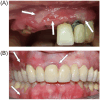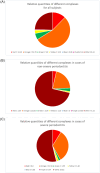Periodontal and microbiological data in patients with mucous membrane pemphigoid in a French population in 2021-2022: A pilot cross-sectional study
- PMID: 39072352
- PMCID: PMC11273292
- DOI: 10.1002/hsr2.2163
Periodontal and microbiological data in patients with mucous membrane pemphigoid in a French population in 2021-2022: A pilot cross-sectional study
Abstract
Background and aims: In the case of mucous membrane pemphigoid with gingival expression (gMMP), the complete healing of the gingiva is generally not achieved despite medical treatment. Therefore, patients' oral comfort is impaired. The dysbiotic periodontal microbiota, generated by a lack of oral hygiene associated with persistent gingival pain, could the immunopathological mechanism to persist. The main objective of this study was to characterize the subgingival microbiota of the gMMP patients, and to highlight a potential link between this microbiological data and the clinical data.
Methods: Subgingival biofilm was collected from 15 gMMP patients, medically treated or not, but not receiving periodontal treatment. The usual clinical periodontal parameters were recorded. The biofilm was analyzed by polymerase chain reaction quantitative. The risk factors of severe erosive gingivitis and severe periodontitis were assessed using Chi-square or Fischer's exact test were used.
Results: Whatever the medical and periodontal conditions of the patients, the results showed the existence of three main communities of periodontopathic, dysbiotic bacteria. The first including Tannnerella forsythia, Peptostreptococcus micros, Fusobacterium nucleatum, and Campylobacter rectus, was found in 100% of the patients, the second enriched with Treponema denticola in 60% and the third enriched with Porphyromonas gingivalis and Prevotella intermedia in 26%. Furthermore, there was a significant positive link between the duration of gMMP and the severity of erosive gingivitis (p = 0.009), and the loss of deep periodontal tissue (p = 0.04).
Conclusion: This pilot study suggests a high periodontal risk in gMMP patients. The pathological processes, autoimmune on the one hand and plaque-induced on the other, may amplify each other. The application of periodontal therapy is therefore necessary in parallel with medical treatment. Nevertheless, further controlled studies are required to validate and complement these preliminary results.
Keywords: autoimmune blistering disease; cicatricial pemphigoid; dentistry; mucous membrane pemphigoid; periodontal dysbiosis; periodontitis; periodontology.
© 2024 The Author(s). Health Science Reports published by Wiley Periodicals LLC.
Conflict of interest statement
Doctor Frédérick Gaultier and Professor Sophie‐Myriam Dridi declare a conflict of interest in relation to this study as they are active members of the association that funded it. However, these authors also certify that the source of support/financial relationships had no impact on the conduct of the study or the interpretation of the data. The other authors declare no conflict of interest in relation to this study or the ethics approval statement.
Figures




References
-
- Stoopler ET, Sollecito TP, DeRossi SS. Desquamative gingivitis: early presenting symptom of mucocutaneous disease. Quintessence Int. 2003;34(8):582‐586. - PubMed
LinkOut - more resources
Full Text Sources

